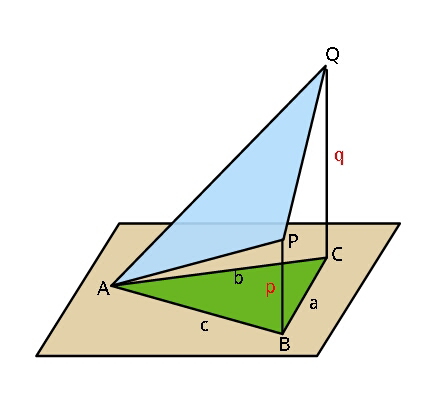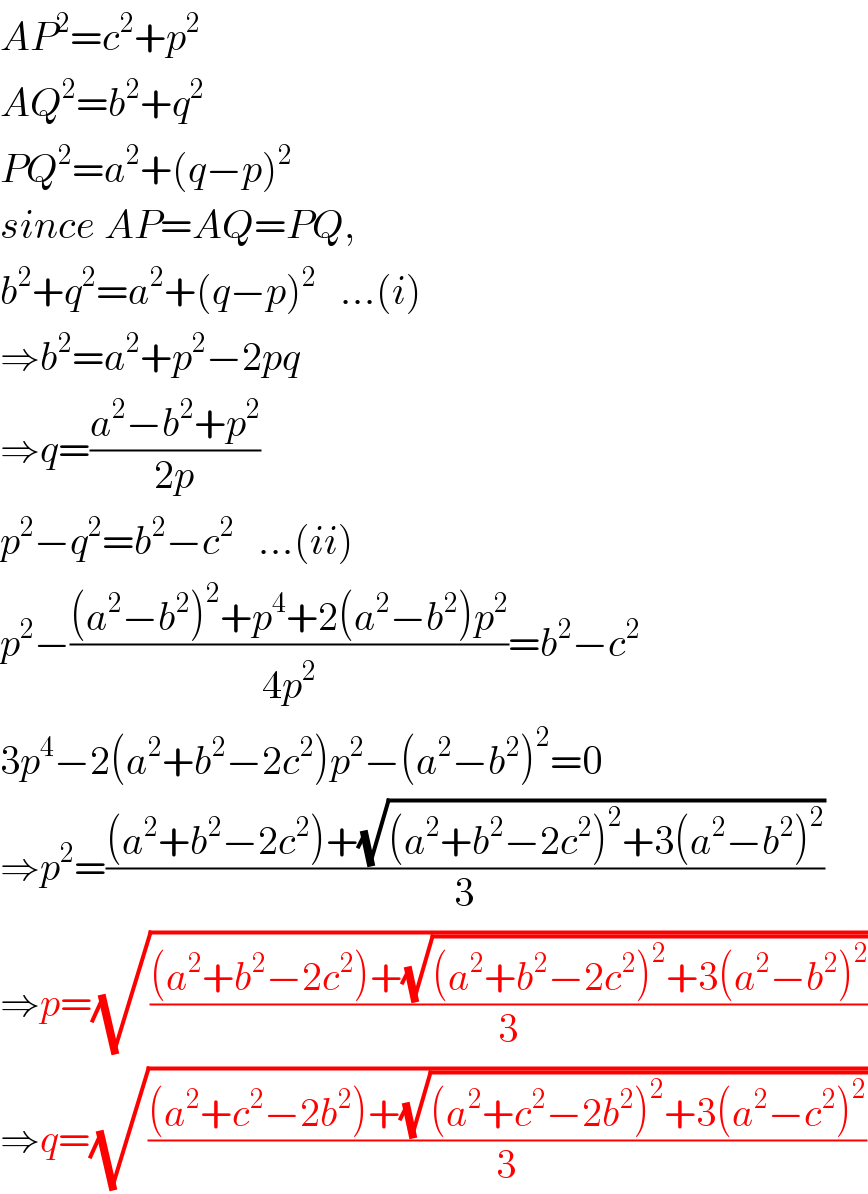Question Number 39678 by ajfour last updated on 09/Jul/18

Commented by ajfour last updated on 09/Jul/18

$$\bigtriangleup{ABC}\:{is}\:{projection}\:{of}\:{an}\: \\ $$$${equilateral}\:\bigtriangleup{APQ}.\:{Find}\:{the}\: \\ $$$${height}\:{p},{q}\:{of}\:{vertices}\:{P}\:{and}\:{Q} \\ $$$${above}\:{ground}\:{in}\:{terms}\:{of}\:\boldsymbol{{a}},\boldsymbol{{b}},\boldsymbol{{c}}. \\ $$
Answered by MrW3 last updated on 09/Jul/18

$${AP}^{\mathrm{2}} ={c}^{\mathrm{2}} +{p}^{\mathrm{2}} \\ $$$${AQ}^{\mathrm{2}} ={b}^{\mathrm{2}} +{q}^{\mathrm{2}} \\ $$$${PQ}^{\mathrm{2}} ={a}^{\mathrm{2}} +\left({q}−{p}\right)^{\mathrm{2}} \\ $$$${since}\:{AP}={AQ}={PQ}, \\ $$$${b}^{\mathrm{2}} +{q}^{\mathrm{2}} ={a}^{\mathrm{2}} +\left({q}−{p}\right)^{\mathrm{2}} \:\:\:…\left({i}\right) \\ $$$$\Rightarrow{b}^{\mathrm{2}} ={a}^{\mathrm{2}} +{p}^{\mathrm{2}} −\mathrm{2}{pq} \\ $$$$\Rightarrow{q}=\frac{{a}^{\mathrm{2}} −{b}^{\mathrm{2}} +{p}^{\mathrm{2}} }{\mathrm{2}{p}} \\ $$$${p}^{\mathrm{2}} −{q}^{\mathrm{2}} ={b}^{\mathrm{2}} −{c}^{\mathrm{2}} \:\:\:…\left({ii}\right) \\ $$$${p}^{\mathrm{2}} −\frac{\left({a}^{\mathrm{2}} −{b}^{\mathrm{2}} \right)^{\mathrm{2}} +{p}^{\mathrm{4}} +\mathrm{2}\left({a}^{\mathrm{2}} −{b}^{\mathrm{2}} \right){p}^{\mathrm{2}} }{\mathrm{4}{p}^{\mathrm{2}} }={b}^{\mathrm{2}} −{c}^{\mathrm{2}} \\ $$$$\mathrm{3}{p}^{\mathrm{4}} −\mathrm{2}\left({a}^{\mathrm{2}} +{b}^{\mathrm{2}} −\mathrm{2}{c}^{\mathrm{2}} \right){p}^{\mathrm{2}} −\left({a}^{\mathrm{2}} −{b}^{\mathrm{2}} \right)^{\mathrm{2}} =\mathrm{0} \\ $$$$\Rightarrow{p}^{\mathrm{2}} =\frac{\left({a}^{\mathrm{2}} +{b}^{\mathrm{2}} −\mathrm{2}{c}^{\mathrm{2}} \right)+\sqrt{\left({a}^{\mathrm{2}} +{b}^{\mathrm{2}} −\mathrm{2}{c}^{\mathrm{2}} \right)^{\mathrm{2}} +\mathrm{3}\left({a}^{\mathrm{2}} −{b}^{\mathrm{2}} \right)^{\mathrm{2}} }}{\mathrm{3}} \\ $$$$\Rightarrow{p}=\sqrt{\frac{\left({a}^{\mathrm{2}} +{b}^{\mathrm{2}} −\mathrm{2}{c}^{\mathrm{2}} \right)+\sqrt{\left({a}^{\mathrm{2}} +{b}^{\mathrm{2}} −\mathrm{2}{c}^{\mathrm{2}} \right)^{\mathrm{2}} +\mathrm{3}\left({a}^{\mathrm{2}} −{b}^{\mathrm{2}} \right)^{\mathrm{2}} }}{\mathrm{3}}} \\ $$$$\Rightarrow{q}=\sqrt{\frac{\left({a}^{\mathrm{2}} +{c}^{\mathrm{2}} −\mathrm{2}{b}^{\mathrm{2}} \right)+\sqrt{\left({a}^{\mathrm{2}} +{c}^{\mathrm{2}} −\mathrm{2}{b}^{\mathrm{2}} \right)^{\mathrm{2}} +\mathrm{3}\left({a}^{\mathrm{2}} −{c}^{\mathrm{2}} \right)^{\mathrm{2}} }}{\mathrm{3}}} \\ $$
Commented by MrW3 last updated on 10/Jul/18

$${This}\:{is}\:{to}\:{say}\:{every}\:{triangle}\:{can}\:{be} \\ $$$${projected}\:{from}\:{an}\:{equilateral}\:{triangle}. \\ $$
Commented by ajfour last updated on 10/Jul/18

$${Very}\:{nicely}\:{handled}\:{Sir},\:{cannot} \\ $$$${be}\:{better}!\:{Thanks}. \\ $$
